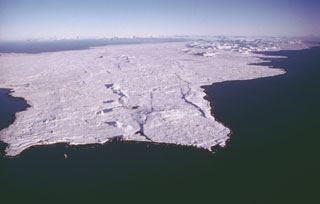Report on Reykjanes (Iceland) — 2 April-8 April 2025
Smithsonian Institution / US Geological Survey
Weekly Volcanic Activity Report, 2 April-8 April 2025
Managing Editor: Sally Sennert.
Please cite this report as:
Global Volcanism Program, 2025. Report on Reykjanes (Iceland) (Sennert, S, ed.). Weekly Volcanic Activity Report, 2 April-8 April 2025. Smithsonian Institution and US Geological Survey.
Reykjanes
Iceland
63.817°N, 22.717°W; summit elev. 140 m
All times are local (unless otherwise noted)
The Icelandic Meteorological Office (IMO) reported that the eruption that began at 0945 on 1 April near the Sundhnúkur crater row, located between Stóra-Skógfell and Sýlingarfell within the Reykjanes volcanic system, was over at 1645 on that same day. Data collected during an overflight conducted by the Icelandic Institute of Natural History on 1 April indicated that about 0.4 million cubic meters of lava had erupted, making it the smallest eruption of the series that began in December 2023 and one sixth of the volume of the second smallest eruption that occurred in January 2024. The flow field was about 0.23 square kilometers and had an average thickness of 1.7 m. Some incandescence on the flow field was visible during 1-2 April as lava cooled. More than 25 cm of subsidence was detected at a GPS station in Svartsengi, though by 1450 on 2 April the rate had significantly slowed. Minor seismicity continued to be recorded, though the earthquake magnitudes had decreased. Several GPS stations recorded at most about 50 cm of movement or displacement in Grindavík, spread over several cracks visible throughout the town. At 1212 on 3 April the Aviation Color Code was lowered to Yellow (the second lowest level on a four-color scale). Subsidence was no longer measured. Deformation data indicated that the northernmost part of the intrusion, about 4 km N of Keilur, remained active, and inflation resumed in Svartsengi, during 3-4 April, though seismicity was decreasing.
Geological Summary. The Reykjanes volcanic system at the SW tip of the Reykjanes Peninsula, where the Mid-Atlantic Ridge rises above sea level, comprises a broad area of postglacial basaltic crater rows and small shield volcanoes. The submarine Reykjaneshryggur volcanic system is contiguous with and is considered part of the Reykjanes volcanic system, which is the westernmost of a series of four closely-spaced en-echelon fissure systems that extend diagonally across the Reykjanes Peninsula. Most of the subaerial part of the system (also known as the Reykjanes/Svartsengi volcanic system) is covered by Holocene lavas. Subaerial eruptions have occurred in historical time during the 13th century at several locations on the NE-SW-trending fissure system, and numerous submarine eruptions dating back to the 12th century have been observed during historical time, some of which have formed ephemeral islands. Basaltic rocks of probable Holocene age have been recovered during dredging operations, and tephra deposits from earlier Holocene eruptions are preserved on the nearby Reykjanes Peninsula.

